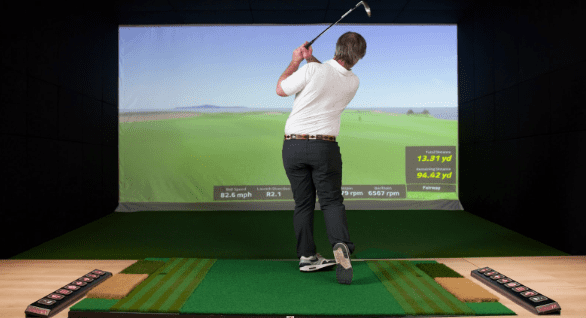Why Indoor Golf is the Future of the Game: Technology, Training, and Fun
Imagine it’s raining, you’ve got an evening free, and instead of cancelling your practice, you step into a warm simulator bay, hit a few focused shots, watch the data, and finish with a practice plan. That scene has now become normal in 2025. Indoor golf is expanding from just basements to clubs, homes, and shared entertainment spaces. And the reason is simple: the tech works in every condition, people like it, and it helps golfers get better fast.
And companies like Golf VX are showing what’s possible when you blend simulators, training, and entertainment into one experience. Let’s discuss what indoor golf actually is, why the tech matters, what research tells us, and the real questions people are asking before they try or buy an indoor golf simulator.
What Is Virtual Indoor Golf?
Indoor golf or virtual golf uses cameras, sensors, and software to recreate golf courses and record your shots inside a room. You hit real balls (or simulated ones) and the system shows ball flight, distance, spin, and more on a big screen. It’s a blend of golf simulator technology, launch monitors, and realistic course software so you can play or train year-round.
Why Does Golf Simulator Technology Matters?
Not all simulators are the same. The accuracy of a system depends on the launch monitor and the method it uses (radar vs. camera/photometric). Indoor golf simulators use state-of-the-art technology to create consistent, tour-level data, which is important if you want real performance feedback. Independent comparisons show differences in metrics like spin and off-center consistency, so pick gear carefully if accuracy is your priority. If you don’t have the required resources to set up a simulator, you can also join local indoor golf centers like Golf VX North Dartmouth to play while enjoying food and beverages. They have professional trainers who can help you improve your shots in no time!
Can Training on a Simulator Improve Your Game?
Yes, and the evidence is growing. Recent industry surveys and reports show that many SIM users notice measurable improvement. For example, a survey of simulator owners reported significant stroke reductions and better accuracy after regular use. That’s not universal magic, but when you combine consistent practice, immediate data, and structured drills, you can make real gains.
The National Golf Foundation’s research also highlights indoor golf simulators as an opportunity for facilities to get more players. Simulators help attract more rounds and new players to the sport. That’s a signal that indoor golf isn’t just training tech; it’s a business and participation driver shaping the future of golf.
Why Golfers Love Indoor Golf
Here’s why golfers are turning to simulators, and why you might enjoy them too.
- Convenience: Practice any time, rain or shine.
- Data-driven practice: See club speed, launch angle, spin, and more right away.
- Variety: Play world-renowned courses or run specific drills.
- Social & fun: Sim bays are great for dates, parties, or influencer content. Many golf influencers use Sims to create content and test gear.
Where to Try Indoor Golf Near You
Search for local golf facilities and entertainment centers offering sim bays. Many clubs and new operator concepts (multi-course operators) now include simulators; industry research shows this is a fast-growing service offering.
If you’re based near Arlington Heights, you’ll find several venues like Golf VX Arlington Heights offering state-of-the-art indoor golf experiences, from casual rounds to full practice bays.
How Much Does an Indoor Golf Simulator Cost?
Ranges vary widely: a basic setup can start in the low thousands (for projectors and basic launch monitors), while premium, room-scale systems with top launch monitors can go into five figures. Think about accuracy needs, space, and how you’ll use it. (See reputable reviews for model-by-model comparisons.)
Business of Indoor Golf: Market Growth & Trends
The indoor golf and golf-simulator markets are growing fast. Industry reports estimate the global market will expand significantly through the decade as adoption rises in both private and commercial spaces. That growth fuels more software, better hardware, and more venues for you to try the tech.
Quick Buying Checklist for Your Simulator
Before investing in a simulator, keep these key factors in mind to ensure you get the setup that fits your space, budget, and training goals.
- Decide on your goal: whether you want entertainment, practice, or pro-level training?
- Space, like ceiling height and room depth, matters.
- Launch monitor type, such as radar (good outdoors and for full swing) vs photometric/camera (very accurate indoors).
- Software includes virtual golf courses, practice modes to work on your swing, and analytics to track your performance.
- Plan for the cost of a screen, projector, enclosure, hitting mat, and a launch monitor.
- Pick brands with firmware/software updates and local service options.
Future of High-Tech Golf
More AI coaching, training specific to the player, and even the integration of socials will be expected. The NGF and other observers of the industry view simulators as an engine of growth in the sport, attracting new players and retaining existing ones to play all year round. Simply put, high-tech golf is not a replacement for courses. It is turning golf more accessible, data-rich, and social.
Final Takeaway
When the weather is bad or the time of day is not very favorable, indoor golf simulators can be a brilliant idea to practice your shots. This technology is not new! The market is expanding, and the individuals or businesses that use golf simulators are seeing real results. Give it a trial, view the information, and then you will easily determine whether it will suit your objectives.
FAQs
What is virtual golf?
It’s a simulated golfing experience using sensors and software to recreate courses and measure shots. Short answer: play and practice indoors.
Are golf simulators accurate?
Top-tier launch monitors are highly accurate; lower-cost options are improving quickly. If you need tour-level accuracy, compare radar vs photometric systems and look for third-party tests.
Can simulators improve my score?
Yes, many users report measurable improvement when they practice with data-driven routines. It works best when paired with coaching or a structured practice plan.








